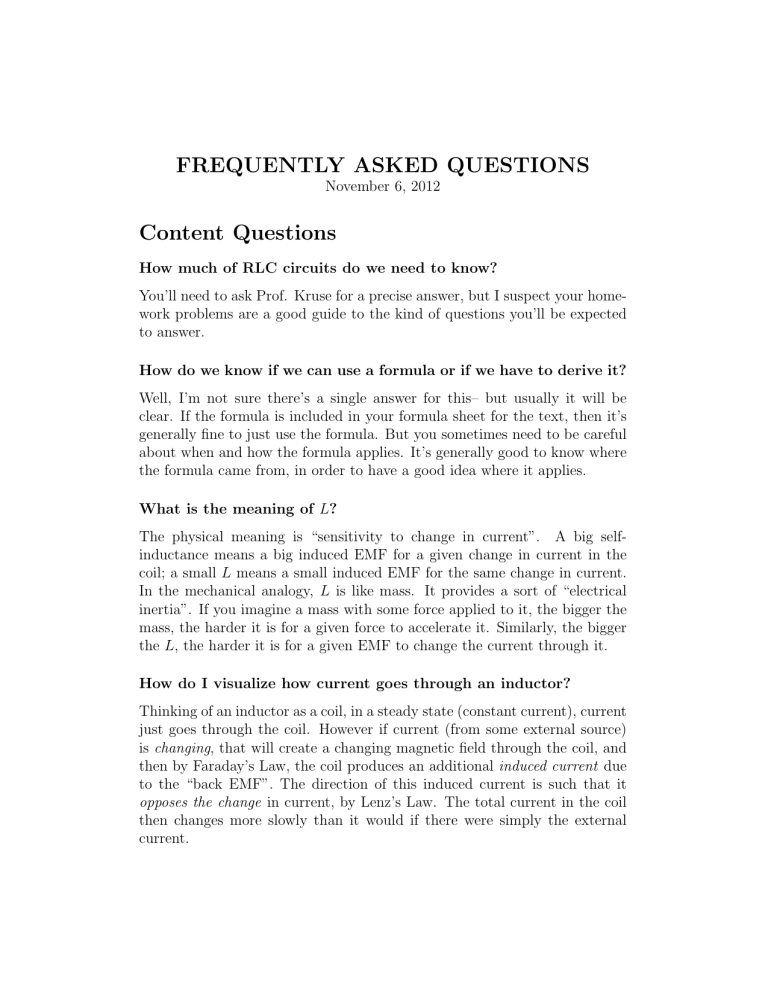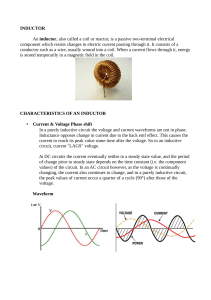FREQUENTLY ASKED QUESTIONS Content

FREQUENTLY ASKED QUESTIONS
November 6, 2012
Content Questions
How much of RLC circuits do we need to know?
You’ll need to ask Prof. Kruse for a precise answer, but I suspect your homework problems are a good guide to the kind of questions you’ll be expected to answer.
How do we know if we can use a formula or if we have to derive it?
Well, I’m not sure there’s a single answer for this– but usually it will be clear. If the formula is included in your formula sheet for the text, then it’s generally fine to just use the formula. But you sometimes need to be careful about when and how the formula applies. It’s generally good to know where the formula came from, in order to have a good idea where it applies.
What is the meaning of L ?
The physical meaning is “sensitivity to change in current”.
A big selfinductance means a big induced EMF for a given change in current in the coil; a small L means a small induced EMF for the same change in current.
In the mechanical analogy, L is like mass. It provides a sort of “electrical inertia”. If you imagine a mass with some force applied to it, the bigger the mass, the harder it is for a given force to accelerate it. Similarly, the bigger the L , the harder it is for a given EMF to change the current through it.
How do I visualize how current goes through an inductor?
Thinking of an inductor as a coil, in a steady state (constant current), current just goes through the coil. However if current (from some external source) is changing , that will create a changing magnetic field through the coil, and then by Faraday’s Law, the coil produces an additional induced current due to the “back EMF”. The direction of this induced current is such that it opposes the change in current, by Lenz’s Law. The total current in the coil then changes more slowly than it would if there were simply the external current.
Although inductors are usually coils, can they be other objects?
Certainly. Just as anything that can hold charge has capacitance, anything that can carry current has self-inductance and can be treated as an inductor in a circuit.
How do you determine the direction of the current when a switch is closed?
It will depend on the situation. Current is in the direction of flow of positive charge. If there’s a battery driving current, the current will go from + to
-. If there’s a charged-up capacitor, the current will go in the direction the positive charge will go. The direction of induced current is such that it will oppose any change in current.
How do you transfer from I to Q ( t ) ?
The current is the rate of change of charge: I = dQ
. If you know Q ( t ) and dt you need I ( t ), take the derivative. If you know I ( t ) and you need Q ( t ), take the integral.
How do you use equation 32.6? Where does the resistance come from in the exponential?
In problem 32-66, the idea is to write Kirchoff’s Loop Rule for the loops, and get a differential equation that can be manipulated algebraically into the same form as equation 32.6 in section 32.2 of the text, ε − IR − L dI = 0. In section 32.2, this differential equation is solved: the answer is I = dt
ε
(1 − e
− Rt/L ).
R
So if you can get an equation with the same form but different constants, you know the solution just by substituting the constants. In problem 32-66, you get the same equation with R
1
→ R , and L (1 + write down the answer with those substitutions.
R
1
/R
2
) → L , so you can
How did you find Q max in the homework LC problem?
In problem 32-49, the maximum charge on the capacitor is just the charge on the capacitor at the moment the switch is thrown. This is just Q = Cε .
How do you go from a differential equation to a sinusoidal equation for current?
The sinusoidal equation is the solution to the differential equation. Taking as an example the LC circuit, Kirchoff’s loop rule gives the differential equation d
2
Q dt
2
= − 1 Q . This is an equation for Q ( t ). It’s asking the question: “What
LC function Q ( t ), if you differentiate it twice, gives you the same function Q ( t ) times − 1
?” The answer to that question is a sinusoid: Q ( t ) = sin( ωt + φ ),
LC where ω = q
1 (and the current is the derivative of that). The solution to
LC the DE is an expression that describes how the charge behaves as a function of time.
What is φ in I ( t ) = I max sin( ωt + φ ) ?
The quantity φ is a “phase constant” or “phase shift” that determines what the value of I ( t ) is at t = 0. The general solution to the DE has this constant, and the initial conditions will determine the value of φ : for example if I = I
0 at t = 0, then I
0
= I max sin φ , and you can solve for φ .
How do you know whether to use a sine or a cosine function for current or voltage when dealing with an AC circuit?
Either will work. You can write current as a function of time is I max sin( ωt +
φ ), where φ is the phase shift. Because sin( ωt ) is the same as cos( ωt − π/ 2), the difference is just a different chosen phase shift.
What exactly do you mean by a “steady-state situation”?
“Steady-state” generally means a situation in which the current does not change. If there’s an AC power supply, it’s not steady state, since the power supply is driving the current back and forth and there’s in general a non-zero dI/dt at any given time. However, for a DC power supply (which provides constant voltage), the situation may or may not be steady state. There may be a “transient” situation, for which there’s current changing over a short period of time, but after a long time the situation will settle to a steady state. An example would be closing or opening a switch to add or remove a battery: current may initially change, but then reach a final “steady-state” value after a long time, or go to zero, depending on the situation.
What would happen with a constant DC voltage? Is that a steady state?
It may be or not, depending on the situation. As mentioned above, you can have a “transient” situation with a DC voltage, for which the situation isn’t steady until it’s settled down after a long time.
Where does the mechanical analogy come from?
Why are the variables analogous to each other?
It comes from the fact that the same math describes the behavior of a mechanical system and of an electrical system. You can see that the variables
(e.g.
Q for x and so on) are analogous, just by substituting them. The equation is the same, just different variable names – so the solutions for each case must show the same behavior.
What are I rms and V rms
?
The abbreviation “rms” stands for “root mean square”.
the peak voltage is I rms
= I max
/
V max simply by V rms
= V max
/
V rms is related to
2. Similarly, the rms current
2. Generally, if you are told that a power supply is a “60 V power supply”, 60 V refers to the rms voltage.
So where does that 2 factor come from? It comes from the evaluation of power dissipated in an AC circuit. Power at any time t is P = I 2 ( t ) R , and since current varies with time, power does too. What we really care about is the average power. For I = I max sin ωt , the average power is P =
I 2 max
R sin
2
P =
1
2
I
2 max
ωt . The average over time of a sine wave comes out to 1 / 2, so
R (see Fig 25-20 in your text). So P = I
2 rms
R . So the reason we use rms is that rms quantities are the ones that follow the “ P = I 2 R rule” for average power in AC circuits.
Why do you use V rms
?
See above question: average power dissipated depends on rms current and voltage.
Why is AC current useful?
One reason is that it’s easy to generate: a rotating loop in a magnetic field gives a sinusoidal current, so it’s straightforward to convert mechanical power to AC electrical power.
But one of the main reasons AC power is so popular is that it’s possible to easily step up and step down voltage levels with a transformer. Power transmission is more efficient over long distances at high voltage, so it’s good to be able to change from high to low voltage easily (see Sections 27.6 and
33.8 in your text for discussion of power transmission).





